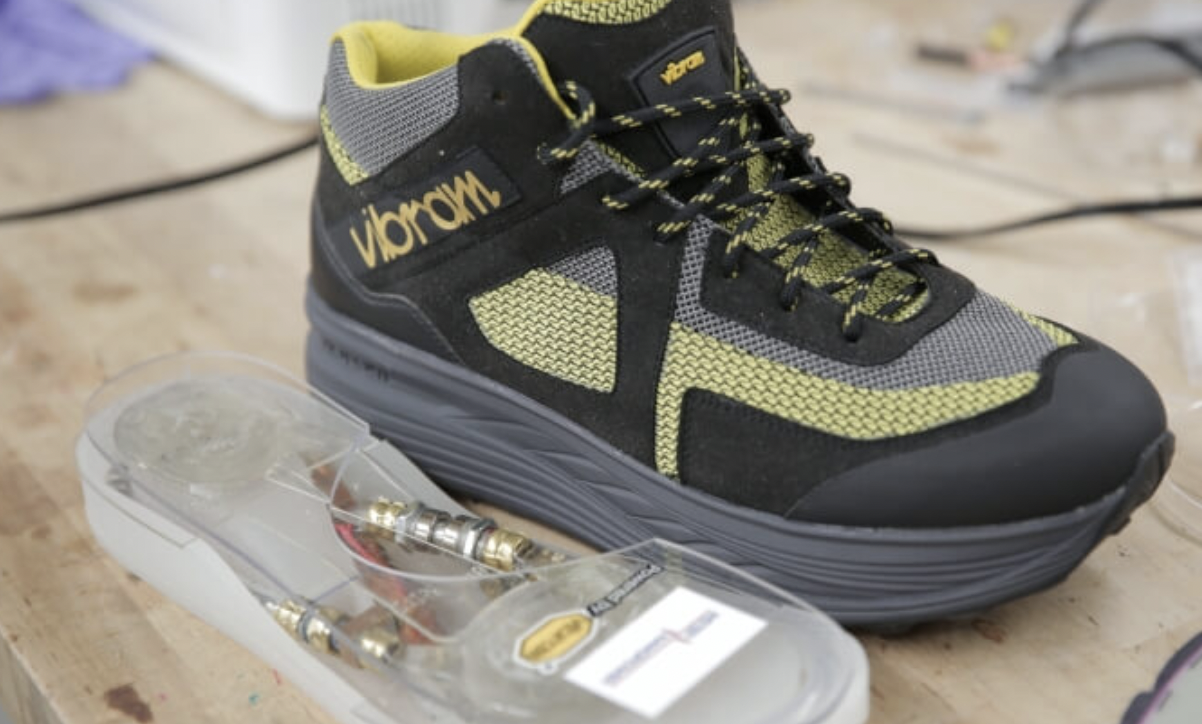 ホーム
ホーム
 エネルギー状況
エネルギー状況
 再生可能エネルギー
再生可能エネルギーについて
 エネルギーを考える
エネルギーを考える
 節電意識チェック
節電意識チェック
 まとめ
まとめ
 Language
Language
すでにある身近で使える発電器具
身近で発電できる器具で送電コストを抑えることができないか調べているなかで、「エネルギーハーベスティング」を知りました。
エネルギーハーベスティングとは身の回りにある熱や振動などさまざまな形態の密度の低いエネルギーを「収穫」して電気エネルギーに変換する技術です。
比較的古くからある技術で、例えば、太陽光で充電する腕時計や電卓はエネルギーハーベスティング技術を活用した製品として既に普及していることがわかりました。
このページでは、エネルギーハーベスティングの種類と、既に製品化されている例を紹介します。
光発電
光エネルギーをエネルギー源として使用する発電技術は光発電と呼ばれ、太陽光や白熱灯、蛍光灯、LED等の照明からの光エネルギーを収穫し、電力を得るエナジーハーベスティング(環境発電)技術です。
太陽電池の材料も様々有り、シリコン結晶太陽電池、シリコンアモルファス太陽電池、色素増感太陽電池、有機薄膜太陽電池、CIS太陽電池、CIGS太陽電池等があります。
それを使った商品が太陽光で充電できるモバイルバッテリーです。

大容量モバイルバッテリー
『持ち運びできる太陽光発電機』
自分が使うスマホの電気をまかなえるかもしれないまさに、持ち運びできる太陽光発電機です。
ソーラーパネルでフル蓄電にかかる時間は140時間でiPhoneなら7回充電できます。
1日一回は充電できる計算ですね。
価格は3800円くらいですが、スマホの充電一回にかかる電気代は1円ほどなのでもとを取るには10年以上かかってしまいます。
振動発電
振動エネルギーをエネルギー源として使用する発電技術は振動発電と呼ばれ、モーター、エンジン、その他の機械の発する振動エネルギー、橋や道路等の建造物が発する振動エネルギーを収穫し、電力を得るエナジーハーベスティング(環境発電)技術です。
発電素子として圧電素子(ピエゾ素子)を使用するものや、静電誘導、電磁誘導を使用するもの等があります。

歩くだけで発電できる靴
ウィスコンシン大学では歩くだけで発電できるシューズが開発途中でした。
機械工学の教授 Tom Krupenkin
によると、「歩く」という運動は理論上、両足の靴で合計20Wもの決して無視できない量のエネルギーを発生し、それはほとんどのモバイルデバイスに必要な電力を供給できるとのことです。
引用元サイト
歩くだけで発電するハイテクシューズ(外部リンク:ウィスコンシン大学)
熱電発電
熱エネルギーをエネルギー源として使用する発電技術は熱電発電と呼ばれ、モーター、エンジン、その他の機械の発する熱エネルギー、ビルや工場の配管等から発する熱エネルギーを収穫し、電力を得るエナジーハーベスティング(環境発電)技術です。
ゼーベック素子(ペルチエ素子)を利用した温度差発電が主流です。
日本ではヤマハが熱電発電を利用し、排出ガスの熱エネルギーから発電することができ、工場排熱などの有効活用をはじめ、コジェネレーション、地熱や太陽熱を用いた発電などにも活用できるモジュールとして開発を進めていることがわかりました。
電磁波発電
電磁波エネルギーをエネルギー源として使用する発電技術は電磁波発電と呼ばれ、テレビ、ラジオ、携帯電話、無線LAN等の電波エネルギーを収穫し、電力を得るエナジーハーベスティング(環境発電)技術です。
レクテナを使用して電波のエネルギーを直流電流に変換します。
電力線の漏れ磁束を使用して発電する磁場発電もあります。
その他・人力発電

自転車で発電
自転車を使って発電する製品をクラウドファンディングで開発している会社もありました。
自転車のペダルを踏んで運動エネルギーをを電気エネルギーに変換することができ、地球にやさしいグリーンエネルギーが作れます。

手回しラジオ
『手回しラジオ』について、よく耳にすると思います。
充電方法として大体1分間に120~140回ほど回すと書いてありましたが、実際にやってみた方の感想としては、回しづらく、疲れる、とのことです。
防水機能がない商品も見受けられたので購入を検討する際は慎重に情報を集めるべきと思いました。
まとめ
調べた結果、今のところ価格と性能が見合う製品はあまりないと思いました。
しかし、これからエネルギーハーべスティングについての研究が更に進めていくにつれ、実用的で、革新的な物が出来ていくという風に思います。
次のページはエネルギーハーベスティングの技術を使って、私たちの生活で自家発電する未来を考えてみました!
Present a product 『Power generation tools』
I learned about "energy harvesting" while investigating whether it
would be possible to reduce power transmission costs with equipment
that can generate electricity in our daily lives.
Energy harvesting is a technology that "harvests" various forms of
low-density energy such as heat and vibration around us and converts
it into electrical energy. It has been found that relatively old
technologies, such as wristwatches and calculators that charge with
sunlight, are already widespread as products that utilize energy
harvesting technology.
This page introduces the types of energy harvesting and examples
that have already been commercialized.
Light power generation
Power harvesting technology that uses light energy as an energy source is called photovoltaic power generation, and is an energy harvesting technology that obtains power by harvesting light energy from lighting such as sunlight, incandescent lamps, fluorescent lamps, and LEDs. There are various materials for solar cells, such as silicon crystal solar cells, silicon amorphous solar cells, dye-sensitized solar cells, organic thin-film solar cells, CIS solar cells, and CIGS solar cells. The product using it is a mobile battery that can be charged with sunlight.

Large capacity mobile battery
"Portable solar power generator"
It may be able to supply the electricity for the smartphone you
use. It takes 140 hours to fully charge the battery with a solar
panel, and the iPhone can be charged 7 times. It can be charged
once a day. The price is about 3800 yen, but it takes more than
10 years to get the money because the electricity bill for one
charge of the smartphone is about 1 yen.
Vibration power generation
Energy harvesting that uses vibration energy as an energy source is called vibration power generation, and energy harvesting that obtains power by harvesting vibration energy generated by motors, engines, and other machines, and vibration energy generated by structures such as bridges and roads. (Energy harvesting) technology. Some power generation elements use piezoelectric elements (piezo elements), while others use electrostatic induction and electromagnetic induction.

At the University of Wisconsin, shoes that can generate
electricity just by walking were under development.
Professor
of Mechanical Engineering "Tom Krupenkin" According to the
theory, the exercise of "walking" produces a total of 20W of
energy in shoes on both feet, which is a non-negligible amount
of energy, which can supply most mobile devices with the
necessary power.
⬇︎Source site
High-tech shoes that generate electricity just by walking (external link: University of Wisconsin)Thermoelectric power generation
Power generation technology that uses heat energy as an energy source is called thermoelectric power generation, and energy harvesting (energy harvesting) that obtains power by harvesting heat energy generated by motors, engines, and other machines, and heat energy generated from pipes in buildings and (Environmental power generation) technology. Temperature difference power generation using Seebeck elements (Pertier elements) is the mainstream.
Yamaha can use thermoelectric power generation to generate electricity from the thermal energy of exhaust gas, and is developing it as a module that can be used for cogeneration, power generation using geothermal heat and solar heat, as well as effective utilization of factory exhaust heat.
Electromagnetic wave power generation
Power generation technology that uses electromagnetic energy as an energy source is called electromagnetic power generation, and is an energy harvesting (environmental power generation) technology that harvests radio energy from televisions, radios, mobile phones, wireless LANs, etc. to obtain power. Uses a rectenna to convert radio energy into direct current. There is also magnetic field power generation that uses the leakage flux of the power line to generate power.
Others ・ Human power generation

Power generation by bicycle
Some companies have used crowdfunding to develop products that
generate electricity using bicycles.
You can step on the pedal of your bicycle to convert kinetic
energy into electrical energy, and you can create earth-friendly
green energy.

Hand-cranked radio
『Hand-cranked radio』As you often hear, it says that you turn
it 120 to 140 times a minute, but the impression of those who
actually tried it is that it is difficult to turn and it makes
you tired.
Some of them do not have a waterproof function, so I thought it
was better to be careful when considering purchasing.
summary
As a result of my research, I thought that there are not many
products that match the price and performance so far.
The next page uses energy harvesting technology to think about the
future of self-power generation in our lives!